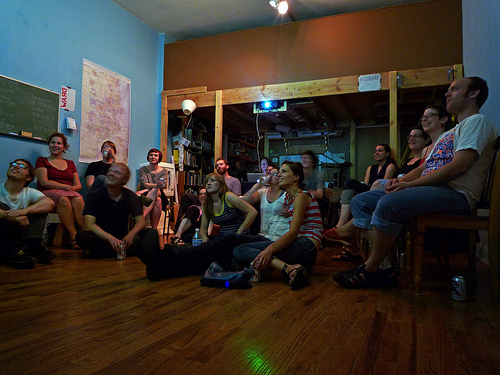
Hideous Beast, "Mini Movie Fest hosted during their InCUBATE residency," 2008. Courtesy Charlie Roderick.
Last November, the National Endowment for the Arts established a new funding category explicitly for artist communities. The NEA defines an artist community as “an organization, whether focused on a single discipline or multidisciplinary, whose sole mission is to provide artist residencies.” This unprecedented recognition of the importance residencies play in the contemporary art ecology also serves as a way for the NEA to support the activities of individual artists without the political liability of direct grants to them. The recent dust-up over an NEA conference call encouraging artists to support certain domestic policy agendas is only the most recent example of how the agency continues to be a political flashpoint.
Residencies are an important step in one path to professionalization taken by artists today. Many artists’ CVs have subheadings devoted to residencies they’ve been on, in addition to documenting their education, exhibitions they’ve shown in, and collections to which their work belongs. Residencies serve artists from every discipline, who benefit from them in a variety of ways. They provide devoted studio space and time to complete work and allow artists to operate in new contexts. They serve as postgraduate institutions where artists can continue working out ideas in a social setting. They offer facilities that an artist might not normally have access to and potential collaborators they might not ever have met. Some residencies are invite-only, and others have competitive application processes. This diversity of organizational models is what allows residencies to serve so many artists — the precise reason that funding them makes sense for the National Endowment for the Arts.
But in addition to the residency organizations currently eligible for funding by the NEA, those that run as non-profit 501(c)(3)’s, there exists a great number of unconventional residencies operating under independent organizational models and at radically different scales. They don’t have traditional boards and tend not to be eligible for public funding. Sometimes they operate out of a spare bedroom at the home of the artist or administrator in charge. Others are nomadic, and never work out of a fixed place. Some are hosted in a string of places that open and close as spaces become available. All of them nurture especially strong connections between the artist on the residency and person or persons who administrate it. With administrative duties minimized, the administrators of these residencies take especially active roles in shaping the artist’s work. What they may lack in artist’s facilities, they compensate for with an intense investment in the artist’s residency experience.
For the past two years, I’ve co-run just such a residency as a member of The Institute for Community Understanding Between Art and the Everyday (InCUBATE). In that time, we’ve hosted fourteen residents (including four collectives) out of a storefront in Chicago. InCUBATE is a research group dedicated to exploring and documenting experimental approaches to arts administration and arts funding. In addition to running the residency, we produce and participate in exhibitions, organize public programs, and co-manage the storefront with three other organizations. We accept applications from people working in any discipline to come stay in a bedroom at our storefront from one to three months and work with us on their projects. These projects are generally interdisciplinary, and produce some sort of resource available for public use. The InCUBATE residency is an opportunity for us, as young arts administrators, to both test out ideas and to collaborate with a wide variety of people whose work we’re interested in.
My own personal investment in unconventional residencies led me to the Alliance of Artists Communities in Providence, Rhode Island. I spent six weeks there this past summer researching other groups and spaces operating residencies at scales and with values similar to InCUBATE’s. Over the course of the next two weeks, I’ll be conducting interviews with some of these residencies and posting them here. I hope to show that they make up an important informal system for a host of people working in modes outside or parallel to traditional art infrastructures.



